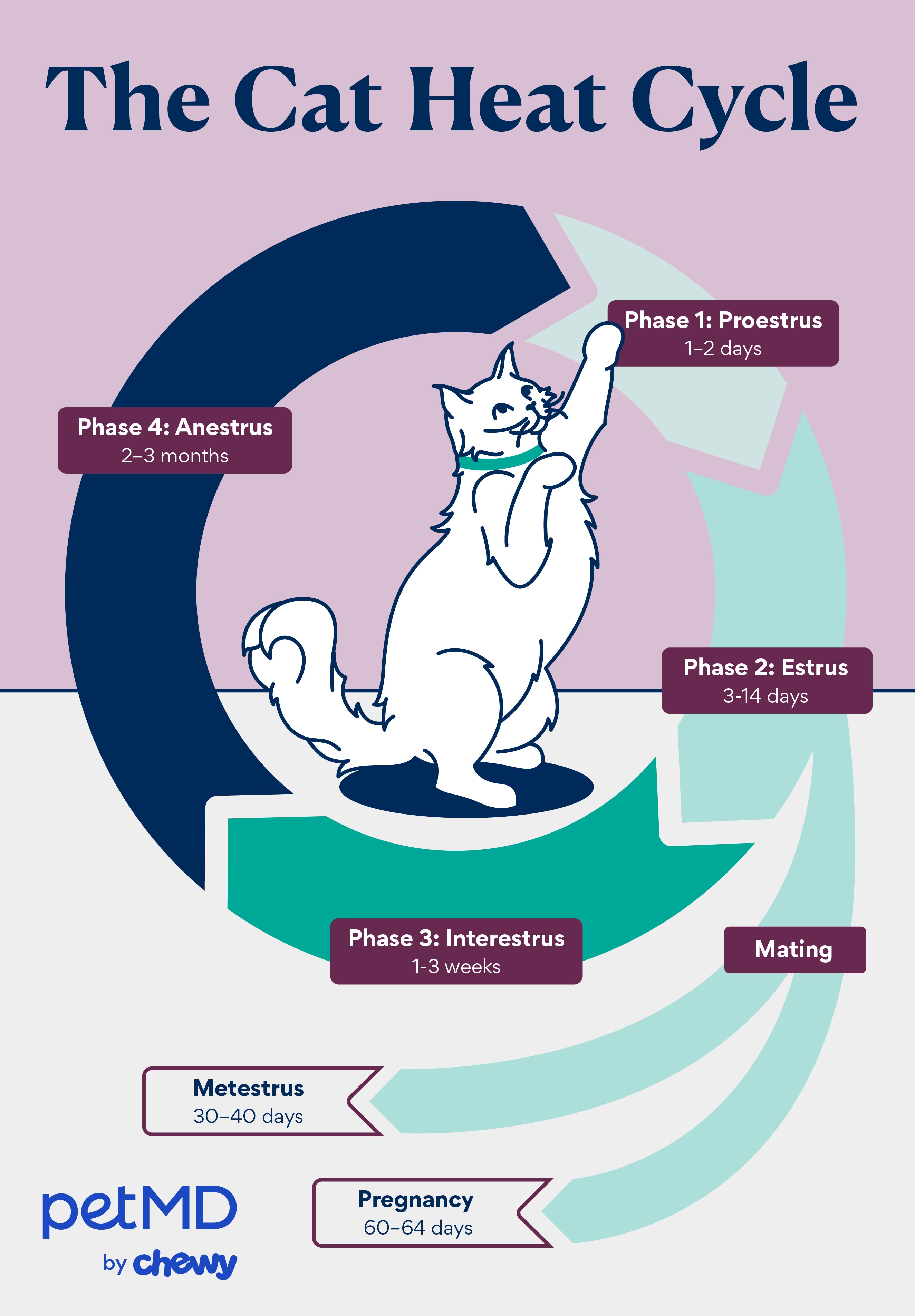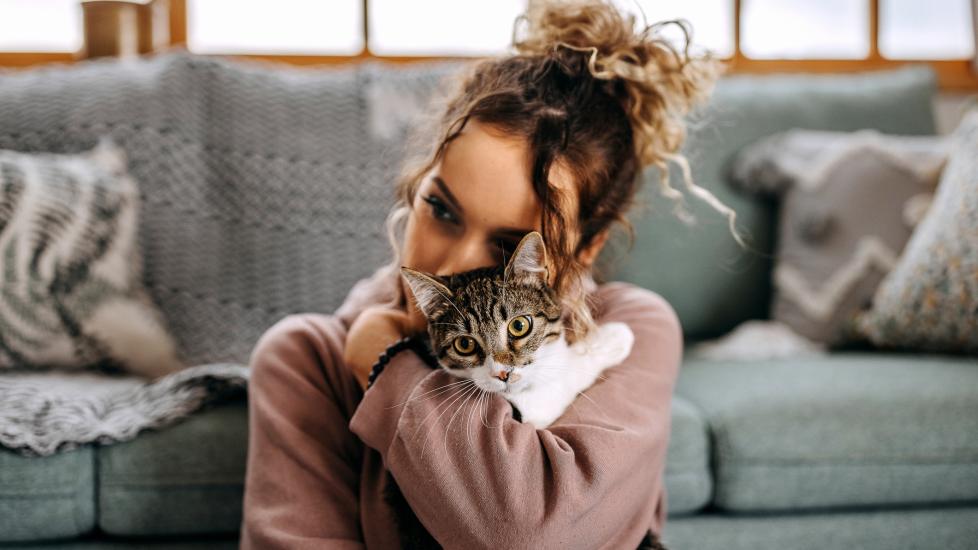Cats in Heat: How Long It Lasts and What To Do
Pekic/E+ via Getty Images
To produce kittens, intact female cats (known as queens) go through a heat, or estrous, cycle. The estrous cycle in cats is extremely different from the cycle of dogs and humans, and it’s important to recognize the signs of a cat in heat if you haven’t spayed your kitty.
At What Age Do Cats Go into Heat?
Most cats start going into heat at 5–9 months of age. Some kittens start cycling as early as 3–4 months old, while others may not experience the first heat until they’re 18 months old. Timing depends heavily on your cat’s breed, weight, and even the time of year.
How Long Are Cats in Heat?

The cat heat cycle varies in length and is made up of four basic stages:
Proestrus
The first stage of a female cat in heat is called proestrus, when estrogen levels start to rise. This usually lasts one or two days, and there are no symptoms of proestrus visible to humans. Male cats may show an increased interest in the female during this time, but she will not be interested in them.
Estrus
Estrus is the most obvious phase of the feline heat cycle and lasts about a week (though it can be anywhere between three and 14 days). The estrus stage is what many people mean when they say a cat is “in heat.”
When in estrus, a female cat may show many behavioral changes, such as becoming overly affectionate, vocalizing excessively, and acting restless. This is also the stage where mating occurs.
Interestrus or Metestrus
Interestrus and metestrus are the possible time frames between estrus cycles. Cats are known as induced ovulators, which means their ovaries only release eggs if they mate with a male cat.
-
If a cat in estrus mates, eggs are released by the ovaries and there is a pause in the cycle. If no eggs are fertilized, this stage is called metestrus, lasting 30–40 days long. Fertilized eggs will result in a pregnancy (60–64 days long).
-
If a cat in estrus does not mate or release eggs, she will go into a one- to three-week interestrus, where in-heat behaviors decrease, and then restart the cycle at proestrus.
Anestrus
Cats only cycle at certain times of year. In between active cycles, there will be two to three months without any hormone activity. This time is known as anestrus.
How Often Do Cats Go into Heat?
Most cat heat cycles are influenced by season and hours of daylight. Cats are known as “long-day breeders” because their heat cycles are more frequent starting in the spring (peaking from February to April). Heat cycles will often continue to October or November before anestrus begins, interrupted only if breeding occurs.
Signs That a Cat’s in Heat
Unlike dogs and humans, cats do not bleed during their heat cycle and the majority of symptoms noted by pet parents are behavioral. A cat in heat may:
-
Become overwhelmingly affectionate toward humans and other cats
-
Vocalize excessively to call to male cats
-
Have a poor appetite
-
Be restless
-
Urinate frequently or inappropriately, such as outside the litter box (though these signs are more rare)
Many pet parents get concerned during the heat cycle that their cats are actually in pain due to the severity of the behavior change. Talk to your vet if your cat experiences any sudden behavioral changes.
What To Do When Your Cat Is in Heat
To prevent unwanted pregnancy, female cats should not be allowed outside while they are cycling. Otherwise, there are no necessary lifestyle changes for cats in heat.
If you do not plan to spay your cat, carefully monitor the length and frequency of estrus behaviors to watch for complications like pseudopregnancy (false pregnancy) or mucometra (mucus in the uterus). Pyometra, or infection of the uterus, is a life-threatening issue. Pyometra can occur at any age but is most commonly seen in middle-aged queens.
Take your cat to the vet if she is showing any of the following symptoms during or after her heat cycle:
-
Vaginal discharge
Preventing Heat in Cats
The only way to prevent heat cycles and pregnancy in female cats is to have their uterus and ovaries removed in a spay procedure. Unless your cat is part of an established breeding program, there is no good reason to leave them intact.
Cats that are not spayed are not only frustrating to deal with due to estrus-related behavior changes, but they are also more prone to pyometra, pseudopregnancy, mammary cancer, and ovarian cancer.
There are currently no known health benefits to allowing your cat to go through a heat cycle before spaying, and it’s recommended to spay your kitten at 5–6 months of age to try to avoid the cycle entirely.
Cats in Heat FAQs
Do cats bleed when in heat?
Cats should never bleed or have bloody discharge during a heat cycle or pregnancy, though they can rarely have clear vaginal discharge during proestrus. Vaginal blood in a cat is cause for an emergency vet visit.
Can you spay a cat in heat?
Yes, you can spay your cat even if she is in the middle of a heat cycle. Once a cat starts cycling, waiting months for anestrus to spay them would put them at more risk than pursuing the procedure mid-cycle.
Do male cats go into heat?
Male cats cannot go into heat because they do not have ovarian tissue. Intact males can mate with females at any time.
How many days is a cat in heat?
The “in heat” phase of the estrous cycle (known as behavioral estrus) lasts three to 14 days, usually averaging a week in length.
How do I know if my cat is in heat?
Talk to your vet if you suspect your cat is in heat. Typical signs of cats in heat include behavioral changes such as vocalizing, attention-seeking behavior, and restlessness.
